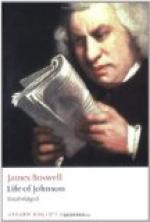At evening we came to Combermere[1180], so called from a wide lake.
JULY 22.
We went upon the Mere. I pulled a bulrush of about ten feet. I saw no convenient boats upon the Mere.
JULY 23.
We visited Lord Kilmorey’s house[1181]. It is large and convenient, with many rooms, none of which are magnificently spacious. The furniture was not splendid. The bed-curtains were guarded[1182]. Lord Kilmorey shewed the place with too much exultation. He has no park, and little water[1183].
JULY 24.
We went to a chapel, built by Sir Lynch Cotton for his tenants. It is consecrated, and therefore, I suppose, endowed. It is neat and plain. The Communion plate is handsome. It has iron pales and gates of great elegance, brought from Lleweney, ‘for Robert has laid all open[1184].’
We saw Hawkestone, the seat of Sir Rowland Hill, and were conducted by Miss Hill over a large tract of rocks and woods; a region abounding with striking scenes and terrifick grandeur. We were always on the brink of a precipice, or at the foot of a lofty rock; but the steeps were seldom naked: in many places, oaks of uncommon magnitude shot up from the crannies of stone; and where there were not tall trees, there were underwoods and bushes.
Round the rocks is a narrow patch cut upon the stone, which is very frequently hewn into steps; but art has proceeded no further than to make the succession of wonders safely accessible. The whole circuit is somewhat laborious; it is terminated by a grotto cut in a rock to a great extent, with many windings, and supported by pillars, not hewn into regularity, but such as imitate the sports of nature, by asperities and protuberances.
The place is without any dampness, and would afford an habitation not uncomfortable. There were from space to space seats in the rock. Though it wants water, it excels Dovedale by the extent of its prospects, the awfulness of its shades, the horrors of its precipices, the verdure of its hollows, and the loftiness of its rocks: the ideas which it forces upon the mind are, the sublime, the dreadful, and the vast. Above is inaccessible altitude, below is horrible profundity. But it excels the garden of Ilam only in extent.
Ilam has grandeur, tempered with softness; the walker congratulates his own arrival at the place, and is grieved to think that he must ever leave it. As he looks up to the rocks, his thoughts are elevated; as he turns his eyes on the vallies, he is composed and soothed.
He that mounts the precipices at Hawkestone, wonders how he came thither, and doubts how he shall return. His walk is an adventure, and his departure an escape. He has not the tranquillity, but the horror, of solitude; a kind of turbulent pleasure, between fright and admiration.
Ilam is the fit abode of pastoral virtue, and might properly diffuse its shades over Nymphs and Swains. Hawkestone can have no fitter inhabitants than giants of mighty bone and bold emprise[1185]; men of lawless courage and heroic violence. Hawkestone should be described by Milton, and Ilam by Parnel.




